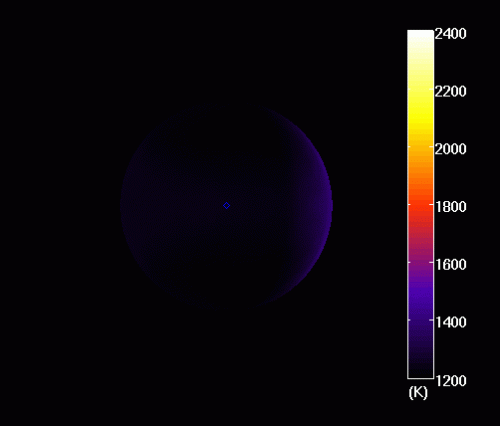Big weather on hot Jupiters

Among the hundreds of new planets discovered by NASA's Kepler spacecraft are a class of exotic worlds known as "hot Jupiters." Unlike the giant planets of our own solar system, which remain at a safe distance from the sun, these worlds are reckless visitors to their parent stars. They speed around in orbits a fraction the size of Mercury's, blasted on just one-side by starlight hundreds of times more intense than the gentle heating experienced by Jupiter here at home."
Meteorologists watching this video are probably wondering what kind of weather a world like that might have. The short answer is "big."
Heather Knutson of Caltech made the first weather map of a hot Jupiter in 2007.
"It's not as simple as taking a picture and—voila!—we see the weather," says Knutson. These planets are hundreds of light years from Earth and they are nearly overwhelmed by the glare of their parent stars. "Even to see the planet as a single pixel next to the star would be a huge accomplishment."
Instead, Knutson and colleagues use a trick dreamed up by Nick Cowan of Northwestern University. The key, she explains, is that "most hot Jupiters are tidally locked to their stars. This means they have a permanent dayside and a permanent night side. As we watch them orbit from our vantage point on Earth, the planets exhibit phases—e.g., crescent, gibbous and full. By measuring the infrared brightness of the planet as a function of its phase, we can make a rudimentary map of temperature vs. longitude."
NASA's Spitzer Space Telescope is the only infrared observatory with the sensitivity to do this work. Since Knutson kick-started the research in 2007, nearly a dozen hot Jupiters have been mapped by astronomers using Spitzer.
The most recent study, led by Nikole Lewis, a NASA Sagan Exoplanet Fellow working at MIT, shows a gas giant named HAT-P-2b. "We can see daytime temperatures as high as 2400 K," says Lewis, "while the nightside drops below 1200K. Even at night," she marvels, "this planet is ten times hotter than Jupiter."
These exoplanet maps may seem crude compared to what we're accustomed to on Earth, but they are a fantastic accomplishment considering that the planets are trillions of miles away.
The maps show huge day-night temperature differences typically exceeding 1000 degrees. Researchers believe these thermal gradients drive ferocious winds blowing thousands of miles per hour.
Without regular pictures, researchers can't say what this kind of windy weather looks like. Nevertheless, Knutson is willing to speculate using climate models of Jupiter as a guide.
"Weather on hot Jupiters," she predicts, "is really big."
Over the years, planetary scientists have developed computer models to reproduce the storms and cloud belts in Jupiter's atmosphere. If you take those models and turn up the heat, and slow down the rotation to match the tidally-locked spin of a hot Jupiter, weather patterns become super-sized. For instance, on a hot Jupiter the Great Red Spot might grow as large as a quarter the size of the planet and manifest itself in both the northern and southern hemispheres.
"Just imagine what that would look like—a pair of giant eyes staring out into space!" says Lewis.
Meanwhile, Jupiter's famous belts would widen so much that only two or three would fit across the planet's girth.
Ordinary clouds of water and methane couldn't form in such a hot environment. Instead, Knutson speculates that hot Jupiters might have clouds made of silicate—that is, "rock clouds."
"Silicates are predicted to condense in such an environment," she says. "We're already getting some hints that clouds might be common on these planets, but we don't yet know if they're made of rock."
For now just one thing is certain: The meteorology of hot Jupiters is out of this world.
Provided by NASA





















